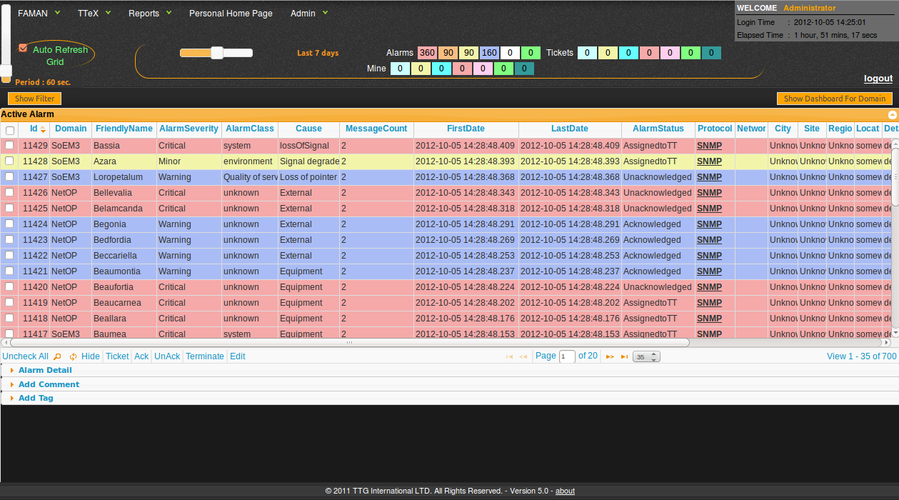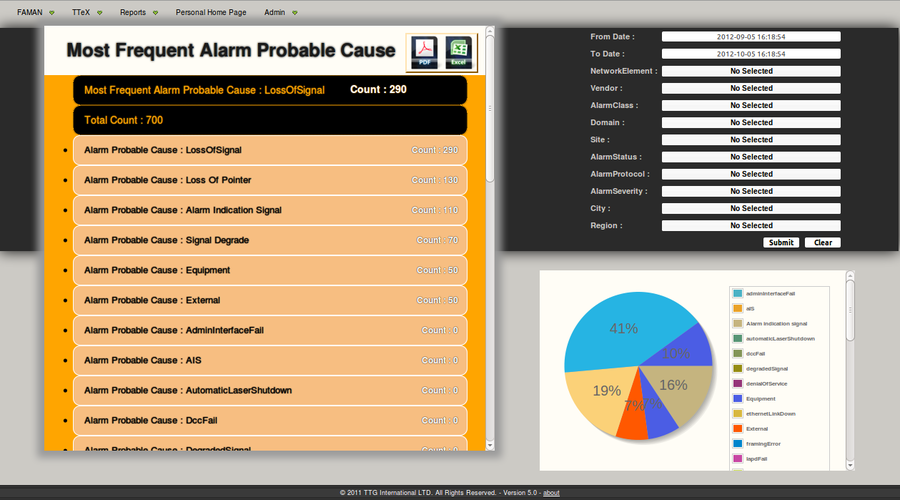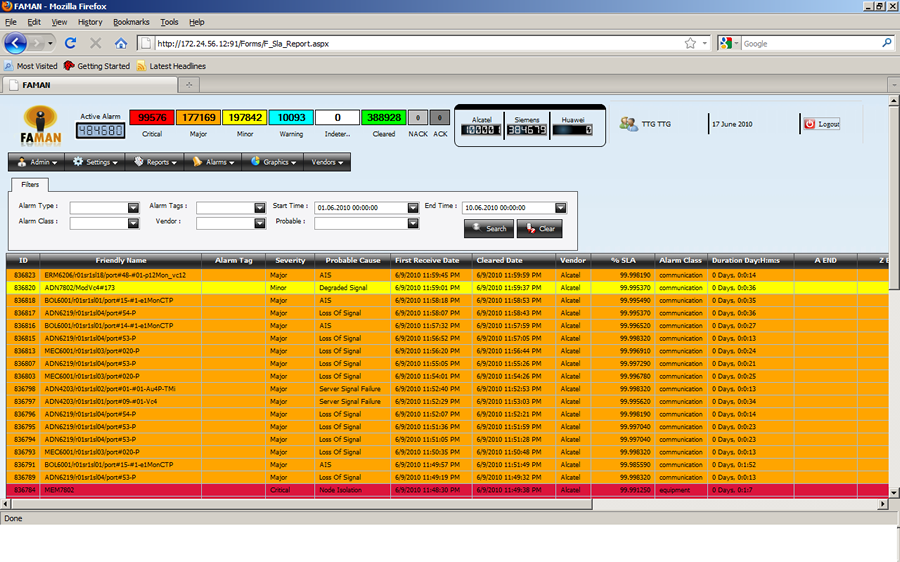
Proactive fault management allows telecom service providers and to maintain the uptime of telecom-based services. In today’s highly competitive telecom market, customer satisfaction requires that problems detected by a Network Management Systems such as TTG’s FAMAN, web based Fault & Alarm Management system which helps operator to detect and assigned Trouble Tickets to personnel or department/s and solve the problems in a timely manner. TTG’s telecom and software engineers has designed FAMAN providing real time alarm monitoring with enhanced alarm correlation and full featured with Trouble Ticket module, providing efficiency resolving the network problems.
Key Benefits
- Real-time, Multi-vendor and multi-domain.
- Lower mean-time-to-repair and increases network uptime and efficiency
- Faster problem resolution by rapidly determining the root cause of a problem
- Prioritizes repair activities according to affected customer or service
- Automatic alarm dispatch (SMS and e-mail) and escalation
- Automates resolution of problems, freeing staff to make better use of their time and expertise
- Efficiently solves network problems and customer reported troubles by automating the creation of trouble tickets
- Alarm vie on Gis
- Tailor network alarm monitoring and management to your specific requirements.


Implementing FAMAN software in your Oss architecture enables you to collect event data from all available sources across your entire network. The system’s advanced software applies powerful data filtering and event correlation functionality to eliminate messages that are insignificant to efficient network operations— up to 80% reduction in the number of alarms you have to process. With drill-down capabilities allow you directly access individual network elements for efficient troubleshooting and problem resolution.
Reports
Reports are supplied as standard with the FAMAN Management Module giving, for example:
- Alarm Summary
- List of the Most Frequent Alarms
- Average Alarm Duration
- SLA reports
- List of objects that generate most of alarms.
- Daily distribution of alarms
- Historical reports
- TT reports, etc
- Many mores
With the report development module your are able to easily define and customized your own reports.


FAMAN helps you keep Qos high. You minimize Mean-Time-to-Repair (MTTR). Your engineers are released from dull alarm-processing tasks and can focus on rectifying network faults. Most important, you ensure rapid problem identification and resolution. In many instances, the time required to process fault alarms, troubleshoot network problems and restore network services can be cut from hours to seconds.
FAMAN provides you with high level views of service available through its topology maps, allowing you to manage your environment based on geography or other criteria. FAMAN’s top-level alarm monitoring is the most used applications in a routine network monitoring. The user can also easily perform troubleshooting activities by opening other application directly from the same screen.


Fault Management
The Fault Management family detects alarms across multi-domain networks and lowers the mean-time-to repair.
Management Functions
- Fault Alarm and event collection, storage and display with filtering
- Fault synchronization on connection establishment through buffering
- Color-coding for alarm severity
- Configurable alarm thresholds
- Alarm rule set
- Reports/development
- Network element connections
- MAP view
- Job scheduler
FAMAN Elements & Components
FAMAN SERVER – A high-speed, in-memory database, optimized for collecting events and designing filters and views, rule set, trouble ticket, integration, reports, report development, etc, which provides the core processing functions for the FAMAN suite. The FAMAN application includes the following components:
Fault Management (FAMAN): Performs alarm filtering and reduction, and presents alarms from the entire network on a single screen.
Fault Correlate: Pinpoints the root cause of network faults using network-wide topology data and conditional rules.
Fault Maintenance: Proactively solves network faults by automatically sending predefined commands to the network elements in response to alarms.
Trouble Ticket: Manages Trouble Tickets from creation through resolution, and facilitates application of known solutions to recurring problems.
Filters: System has flittering for most of the fields such as alarm severity, alarm state, alarm type, by node, etc. as well as Location, Area, Region and so on.
Integration: FAMAN is able to integrate to others tools.
Report Development: System has very flexible and easy to use report development module to help you develop your requirements.
Reports/Statistics: FAMAN has verity of reports (hourly, daily, weekly, monthly and historical) that user are able to get them with a mouse click.
Rule Set: FAMAN (MeerKat) has a rule set that allows user to define their- own rules.
Schedule: FAMAN has a scheduler for predefined jobs such as; Reports, command sending, proactive warring and so on.
Return on Investment from FAMAN
FAMAN low training costs and ease-of-use provides immediate return-on-investment. Off-the-shelf monitors can be quickly installed and immediately begin collecting alarms from different data sources. With quick installation and set-up time, the FAMAN stores alarms, and performs basic correlation. The three key areas where the FAMAN application provides ROI are:
- HIGHER USER PRODUCTIVITY – Through higher network uptime, FAMAN helps the business access the Telecom resources needed to do its job.
- HIGHER SERVICE AVAILABILITY – FAMAN helps enterprises improve service availability and quality through the real-time analysis of network and relevant business-related information.
- STAFF PRODUCTIVITY – FAMAN enables engineers to be more productive, reduces the cost of day-to-day operations and allows new initiatives to be implemented more rapidly.
- EASE-OF-ADMINISTRATION – Centrally manage user accounts and other FAMAN configuration parameters.
